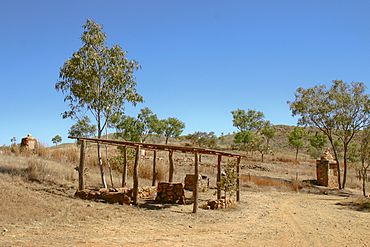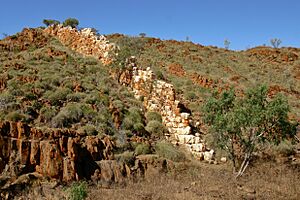Halls Creek, Western Australia facts for kids
Quick facts for kids Halls CreekWestern Australia |
|||||||||
|---|---|---|---|---|---|---|---|---|---|

Ruins of Old Halls Creek
|
|||||||||
| Established | 1887/1949 | ||||||||
| Postcode(s) | 6770 | ||||||||
| Elevation | 422 m (1,385 ft) | ||||||||
| Area | [convert: needs a number] | ||||||||
| Location | |||||||||
| LGA(s) | Shire of Halls Creek | ||||||||
| State electorate(s) | Kimberley | ||||||||
| Federal Division(s) | Durack | ||||||||
|
|||||||||
Halls Creek is a town in the eastern Kimberley region of Western Australia. It sits between the towns of Fitzroy Crossing and Turkey Creek (Warmun) on the Great Northern Highway. It is the only large town for about 600 km along this highway.
Halls Creek is also the northern end of the Canning Stock Route. This long route stretches 1,850 km through the Great Sandy Desert to Wiluna in the south.
The town is an important place for the local Indigenous people. It also helps support the many cattle stations in the area. Halls Creek is the main administration centre for the Halls Creek Shire Council.
Contents
History of Halls Creek
Ancient Roots and Gold Rush Days
The land around Halls Creek has been home to Aboriginal peoples for thousands of years. Ancient songlines and trading paths, used for travel and trade, cross this land. Some of these paths pass close to where the town is today. The stories of this long history are still alive in the culture of the Jaru, Kija, Kukatja, Walmajarri, Gooniyandi, and other Indigenous groups living in the Halls Creek Shire.
In the late 1800s, people from Europe arrived. They were looking for land for cattle and sheep, and also for minerals. On Christmas Day in 1885, a prospector named Charlie Hall found a large gold nugget. It weighed about 28 ounces (794 grams). The place where he found it was later named after him.
News of this gold discovery quickly spread. More than 15,000 people rushed to what is now called Old Halls Creek, hoping to find their own gold. But the land was harsh, and many people struggled. You can still find some graves in the small cemetery at Old Halls Creek.
From Gold Rush to Trading Hub
The gold rush didn't last long, less than three months. After that, Halls Creek became a trading centre. It served the nearby cattle stations, Aboriginal communities, and the few miners who stayed. The town had a post office with a telegraph line, a police station, a government office, a racecourse, and stores. These things gave the town a new purpose. In 1918, the Australian Inland Mission built a hospital. Old Halls Creek continued, but it had few people and not much water.
In 1948, an airfield was built closer to where the town is now. Over the next ten years, the old town slowly moved to this new site. By 1954, Old Halls Creek was mostly empty, except for the police station. The police station finally moved in 1961.
In the 1980s, the Australian government helped fund nearby Aboriginal communities. These were known as Chinaman's Garden (Yarrunga) and Wangu Outstation (Flora Valley Station).
Things to See and Do
Halls Creek has several interesting places for visitors to explore:
- China Wall: A unique natural rock formation.
- Old Halls Creek: The site of the original gold rush town.
- Palm Springs: A beautiful oasis with natural springs.
- Saw Pit Gorge: A scenic gorge to explore.
- Duncan Road: A track offering access to remote areas.
- Wolfe Creek Crater: A large meteor impact crater, about 200 km south on the Tanami Road.
- Purnululu National Park (the Bungle Bungles): Famous for its beehive-shaped domes, about 120 km north.
- Canning Stock Route: The start of this historic route.
You can find more information about tourism in the area.
Indigenous Australian Art
Many talented artists live in Halls Creek and the nearby communities. They create amazing Indigenous Australian art. Some artists sell their work directly. There are also several art centres in the Shire of Halls Creek. Here, you can meet the artists and buy their artworks.
- Yarliyil Art Centre, Halls Creek
- Warlayirti Artists Aboriginal Corporation, Wirrimanu (Balgo) Community
- Warmun Art Centre, Turkey Creek (Warmun) Community
- Laarri Gallery, Yiyili Community
Travel Tips for Visitors
- Alcohol Rules: There are special rules about alcohol in Halls Creek. Since 2009, it's not allowed to buy packaged alcohol with more than 2.7% alcohol content from shops. This rule helped reduce problems like assaults and drink driving. You can still buy full-strength alcohol with a meal at the local motel or hotel.
- Seasons: Halls Creek has two main seasons. The wet season is from November to March, and the dry season is from April to October. During the dry season, it's hard to find natural water sources. In the wet season, Halls Creek can sometimes be cut off by floods. Water levels can rise and fall very quickly.
- Permits: You might need special permits to visit some areas.
Amazing Impact Craters
Besides the famous and well-preserved Wolfe Creek Crater, there are other impact craters nearby.
- Goat Paddock crater: This crater is 7 km wide and located about 106 km west-southwest of Halls Creek.
- Piccaninny crater: This crater is also 7 km wide and is found inside the Purnululu (Bungle Bungle) National Park.
- Gosses Bluff crater: This one is much further away, over 1000 km from Halls Creek in the Northern Territory. It's a 5 km wide, 180 m high feature. Scientists believe it's what's left of the centre of a much larger ancient crater.
Indigenous Population
In the 2016 Census, 1,546 people lived in Halls Creek. About 66.9% of these people were Aboriginal and Torres Strait Islander.
Halls Creek is home to the Indigenous Djaru and Gija peoples. Some Tjurabalan peoples from the desert to the south also live there. Indigenous people have lived in this region for at least 30,000 years.
Many Aboriginal people in Halls Creek are from the Jaru and Kija groups. They often celebrate both heritages. There are also many Gooniyandi people from the east, Walmajarri from the south-east, and Kukatja people from the desert country to the south. Over time, other Aboriginal people from nearby groups have also moved to Halls Creek. These include the Gurindji and the Walpiri from the east, the Ngardi from the south-east, and Malngin from the north-east.
Climate and Weather
Halls Creek has a warm semi-arid climate. This means it has a dry season and a wet season. The weather is warm all year round. July is the coolest month, with an average high of 27.2°C and an average low of 12.6°C. November is usually the hottest month, with an average high of 38.3°C. December has the highest average low temperature at 24.7°C.
The highest temperature ever recorded in Halls Creek was 45.0°C on November 8, 1988. The lowest recorded temperature was 0.2°C on July 18, 1945. It has never frozen in Halls Creek.
Halls Creek gets about 571.5 mm of rain each year. The wet season is from December to March, and the rest of the year is dry. The hottest time of year is just before and at the start of the wet season, from October to January. The dry season is cooler and has bigger differences between day and night temperatures. January is the wettest month, getting about 155.2 mm of rain on average. August is the driest month, with only about 2.1 mm of rain. Humidity is low all year, but it's higher during the wet season. Halls Creek gets a lot of sunshine, about 3439 hours each year.
| Climate data for Halls Creek (1944–2016) | |||||||||||||
|---|---|---|---|---|---|---|---|---|---|---|---|---|---|
| Month | Jan | Feb | Mar | Apr | May | Jun | Jul | Aug | Sep | Oct | Nov | Dec | Year |
| Record high °C (°F) | 44.9 (112.8) |
43.3 (109.9) |
42.2 (108.0) |
39.6 (103.3) |
37.5 (99.5) |
34.4 (93.9) |
34.4 (93.9) |
37.2 (99.0) |
40.2 (104.4) |
43.8 (110.8) |
45.0 (113.0) |
44.9 (112.8) |
45.0 (113.0) |
| Mean daily maximum °C (°F) | 36.7 (98.1) |
35.6 (96.1) |
35.4 (95.7) |
33.8 (92.8) |
30.0 (86.0) |
27.3 (81.1) |
27.2 (81.0) |
30.0 (86.0) |
34.1 (93.4) |
37.1 (98.8) |
38.3 (100.9) |
37.8 (100.0) |
33.6 (92.5) |
| Mean daily minimum °C (°F) | 24.3 (75.7) |
23.7 (74.7) |
22.8 (73.0) |
20.4 (68.7) |
16.8 (62.2) |
13.7 (56.7) |
12.6 (54.7) |
14.8 (58.6) |
19.0 (66.2) |
22.7 (72.9) |
24.5 (76.1) |
24.7 (76.5) |
20.0 (68.0) |
| Record low °C (°F) | 15.6 (60.1) |
17.7 (63.9) |
15.6 (60.1) |
11.0 (51.8) |
7.1 (44.8) |
3.0 (37.4) |
0.2 (32.4) |
4.9 (40.8) |
8.3 (46.9) |
12.8 (55.0) |
13.5 (56.3) |
15.6 (60.1) |
0.2 (32.4) |
| Average rainfall mm (inches) | 155.2 (6.11) |
141.8 (5.58) |
82.7 (3.26) |
21.6 (0.85) |
12.9 (0.51) |
5.2 (0.20) |
6.1 (0.24) |
2.1 (0.08) |
4.4 (0.17) |
17.3 (0.68) |
39.3 (1.55) |
83.1 (3.27) |
571.5 (22.50) |
| Average rainy days | 13.5 | 12.7 | 8.3 | 2.6 | 2.0 | 0.9 | 0.8 | 0.5 | 0.9 | 3.3 | 6.6 | 11.0 | 63.1 |
| Average afternoon relative humidity (%) | 36 | 40 | 33 | 25 | 26 | 25 | 21 | 18 | 16 | 17 | 22 | 29 | 26 |
| Average dew point °C (°F) | 19 (66) |
18 (64) |
17 (63) |
10 (50) |
6 (43) |
4 (39) |
1 (34) |
0 (32) |
2 (36) |
6 (43) |
12 (54) |
17 (63) |
9 (49) |
| Mean monthly sunshine hours | 251.1 | 221.2 | 269.7 | 297.0 | 272.8 | 297.0 | 322.4 | 319.3 | 315.0 | 306.9 | 300.0 | 266.6 | 3,439 |
| Mean daily sunshine hours | 10.5 | 10.2 | 9.1 | 9.5 | 9.4 | 9.0 | 8.1 | 9.9 | 9.9 | 9.8 | 9.6 | 10.2 | 9.6 |
| Source 1: Australian Bureau of Meteorology | |||||||||||||
| Source 2: Time and Date (dewpoints 2005-2015)
Weather Atlas (sun hours) |
|||||||||||||
| Historical population | ||
|---|---|---|
| Year | Pop. | ±% |
| 1986 | 315 | — |
| 1991 | 479 | +52.1% |
| 1996 | 382 | −20.3% |
| 2001 | 1,264 | +230.9% |
| 2006 | 1,211 | −4.2% |
| 2011 | 1,443 | +19.2% |
| 2016 | 1,546 | +7.1% |
| 2021 | 1,605 | +3.8% |
| Source: Shire of Halls Creek ABS (Urban Centres and Localities) |
||



